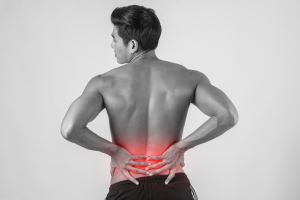What Should You Know About Back Pain?
Back pain is a common problem that afflicts some 80% of the adult population some time or other in their lives.
Many people may suffer from mild back pain from time to time, and their exact cause may be difficult to diagnose. In most cases, they are minor problems caused by a strain to the muscle or ligament.
When severe pain does occur, it may be the result of pressure on nerves from the misalignment of the bones in the back and warrants immediate medical attention.

Overview of the Back
The back can be sub-divided into upper (thoracic) and lower (lumbar) back. The bones in the back are to protect the delicate nerves and support your body weight.
The upper back supports the chest and connects the neck with the lower back. It is made up of 12 thoracic vertebrae and connected to the ribs allowing for the rotational movements of the torso.
The lower back connects your spinal column with the pelvis transmitting the weight to the legs. It’s comprised of 5 lumbar vertebrae and supported by ligaments and muscles. The lower back allows for the bending (forward and backwards) of your torso.
Causes of Back Pain
Back pain may be due to spinal (thoracic or lumbar) or extra-spinal causes. (referred pain from other organs)
For many people, spinal causes of back pain may be associated with a shooting pain or numbness in one or both legs (sciatica). These symptoms can be due to nerve compression over the back. For others, the pain may just be localized to their back.
Pain in the back may involve either the upper or lower back.
The spinal column is made up of multiple spinal segments. These segments include two adjacent vertebral bodies and intervening jelly-like cushion of the intervertebral disc with surrounding ligaments, as well as joints between two bones, called facets.
Pain may arise due to any process in your spine that may give rise to unnatural stresses to the spinal column.
It can range from discogenic causes due to wear and tear of your intervertebral disc and its bulging out into the spinal canal, to other causes of pain due to bones, joints, ligaments, and muscles.
The bones supporting your back may also undergo wear and tear as a result of excessive loading, causing bony spurs to form.
Mechanical back Pain
At times you may experience back pain only after certain activities which may relieve after taking rest.
This type of pain is called mechanical pain, referring to pain arising due to the moving parts of your bones.
Non-Mechanical Back Pain
While the other type is non-mechanical pain that arises due to conditions like tumor and infection.
In non-mechanical back pain, your pain may be continuous or intermittent but is not related to your activity levels.
For some, the pain may shoot down their legs like a sharp electric current. This may happen when your nerves getting pressed at the back at their site of origin and pain travelling along the path of the whole nerve.
Preventing Back Pain with Good Posture
Back pain is also often associated with our everyday movement and posture.
Posture is the position in which you hold your body while standing, sitting or lying down.
Good posture involves training your body to stand, walk, sit and lie in positions where there is less stress exerted on supporting muscles and ligaments, reducing back pain.
Learn more about What is Good Posture.
When to Seek Medical Help
Consult a medical professional if you are experiencing persistent back pain or other associated symptoms which may include:
A spine specialist will be able to determine the cause of your back pain so that remedial measures can be taken to prevent further worsening. He or she will assess your condition and find out what the pain generators are before starting any treatment.
Make an appointment at +65 67370680 or Pinnacle Spine Scoliosis Centre.
Looking For A Reliable Back Orthopaedic Specialist?
Fast Medical Attention, Transparent Fees
Make an appointment for comprehensive care for your back problems!
